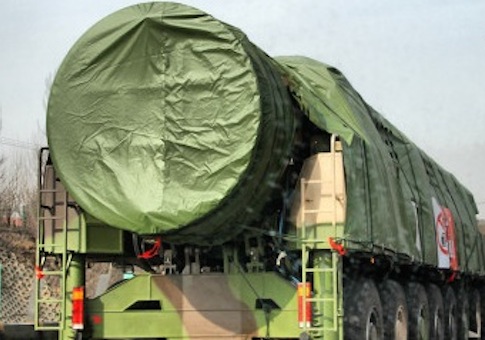China’s Defense Ministry on Thursday confirmed that Beijing fired its newest long-range missile into the South China Sea in a test this week, amid growing tensions between Washington and Beijing.
Responding to a report in the Washington Free Beacon on Tuesday, the ministry defended the missile launch in an unusual confirmation of a nuclear system test.
"It is normal for China to execute scientific experiments within its territory, and these experiments are not aimed at any specific country nor target," the ministry said.
The statement said the long-range missile was test fired "near the South China Sea on April 12."
"The so-called test location reported by the media is pure conjecture," the statement said.
Defense officials disclosed that a new DF-41 missile was launched and carried two dummy warheads that were identified as multiple, independently-targetable reentry vehicles, or MIRVs.
The location of the DF-41 test was not disclosed. Past flight tests were launched from Wuzhai Missile and Space Test Center in central China.
The DF-41 test was closely monitored by U.S. intelligence satellites and other sensors. It came amid growing tensions between China and the United States over disputed islands in the South China Sea.
A large delegation of Chinese military officials, led by Central Military Commission Vice Chairman Fan Changlong, recently traveled to Fiery Cross Reef in the Spratly Islands, which is claimed by Philippines and two other states in the region. Fan’s visit coincided with the visit of Defense Secretary Ash Carter to the aircraft carrier USS Stennis, which was patrolling the South China Sea.
Additionally, the Pentagon objected to China’s use of a military aircraft to rescue injured workers on one of the disputed South China Sea islands. Beijing dismissed the criticism.
The DF-41 is China’s newest and most lethal long-range missile, and one of the few nuclear delivery vehicles that can range the entire United States.
The missile has been under development and testing for the past several years and military analysts say it is nearing deployment.
The new missile will be equipped with between six and 10 MIRVs, representing a major increase in China’s nuclear arsenal. The missile has an estimated range of up to 7,456 miles.
Until it began MIRVing its strategic missiles, China was estimated to have around 250 to 300 strategic warheads, many of them large-yield "city-busters."
The CIA stated in the 1990s that China obtained espionage details about every deployed nuclear warhead used by the United States, including the W-88 small warhead deployed on U.S. submarine-launched ballistic missiles.
This week’s DF-41 test followed an earlier flight test of the new missile on Aug. 6, also with two simulated warheads.
Defense officials also disclosed earlier this year that China has begun upgrading older, single-warhead DF-5 missiles with MIRVs.
The nuclear buildup by China has raised concerns that China is developing a first strike capability using large numbers of mobile missiles with multiple warheads.
China’s military doctrine in the past was that Beijing would not be the first to use nuclear weapons in a conflict.
The Pentagon did not respond when asked about the missile test last week.
